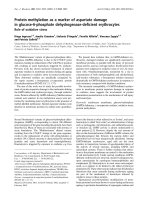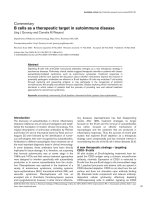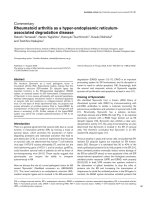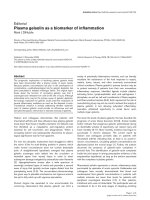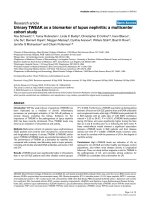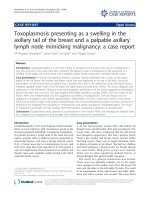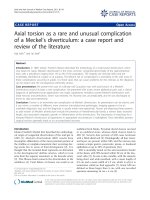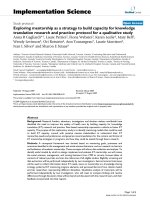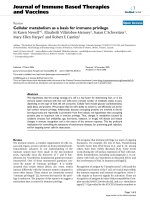Báo cáo y học: " Exploring mentorship as a strategy to build capacity for knowledge translation research and practice: protocol for a qualitative study" pps
Bạn đang xem bản rút gọn của tài liệu. Xem và tải ngay bản đầy đủ của tài liệu tại đây (329.42 KB, 8 trang )
BioMed Central
Page 1 of 8
(page number not for citation purposes)
Implementation Science
Open Access
Study protocol
Exploring mentorship as a strategy to build capacity for knowledge
translation research and practice: protocol for a qualitative study
Anna R Gagliardi*
1
, Laure Perrier
2
, Fiona Webster
3
, Karen Leslie
4
, Mary Bell
5
,
Wendy Levinson
5
, Ori Rotstein
6
, Ann Tourangeau
7
, Laurie Morrison
8
,
Ivan L Silver
2
and Sharon E Straus
9
Address:
1
Toronto General Research Institute, University Health Network, Toronto, Canada,
2
Continuing Education and Professional
Development, Faculty of Medicine, University of Toronto, Toronto, Canada,
3
Centre for Health Services Sciences, Sunnybrook Health Sciences
Centre, Toronto, Canada,
4
Centre for Faculty Development, St. Michael's Hospital, Toronto, Canada,
5
Department of Medicine, Faculty of
Medicine, University of Toronto, Toronto, Canada,
6
Department of Surgery, St. Michael's Hospital, Toronto, Canada,
7
Faculty of Nursing,
University of Toronto, Toronto, Canada,
8
Emergency Medicine and Critical Care, St. Michael's Hospital, Toronto, Canada and
9
General Internal
Medicine, St. Michael's Hospital, Toronto, Canada
Email: Anna R Gagliardi* - ; Laure Perrier - ;
Fiona Webster - ; Karen Leslie - ; Mary Bell - ;
Wendy Levinson - ; Ori Rotstein - ; Ann Tourangeau - ;
Laurie Morrison - ; Ivan L Silver - ; Sharon E Straus -
* Corresponding author
Abstract
Background: Research funders, educators, investigators and decision makers worldwide have
identified the need to improve the quality of health care by building capacity for knowledge
translation (KT) research and practice. Peer-based mentorship represents a vehicle to foster KT
capacity. The purpose of this exploratory study is to identify mentoring models that could be used
to build KT capacity, consult with putative mentee stakeholders to understand their KT
mentorship needs and preferences, and generate recommendations for the content and format of
KT mentorship strategies or programs, and how they could be tested through future research.
Methods: A conceptual framework was derived based on mentoring goals, processes and
outcomes identified in the management and social sciences literature, and our research on barriers
and facilitators of academic mentorship. These concepts will inform data collection and analysis. To
identify useful models by which to design, implement and evaluate KT mentorship, we will review
the social sciences, management, and nursing literature from 1990 to current, browse tables of
contents of relevant journals, and scan the references of all eligible studies. Eligibility screening and
data extraction will be performed independently by two investigators. Semi-structured interviews
will be used to collect information about KT needs, views on mentorship as a knowledge sharing
strategy, preferred KT mentoring program elements, and perceived barriers from clinician health
services researchers representing different disciplines. Qualitative analysis of transcripts will be
performed independently by two investigators, who will meet to compare findings and resolve
differences through discussion. Data will be shared and discussed with the research team, and their
feedback incorporated into final reports.
Published: 19 August 2009
Implementation Science 2009, 4:55 doi:10.1186/1748-5908-4-55
Received: 20 July 2009
Accepted: 19 August 2009
This article is available from: />© 2009 Gagliardi et al; licensee BioMed Central Ltd.
This is an Open Access article distributed under the terms of the Creative Commons Attribution License ( />),
which permits unrestricted use, distribution, and reproduction in any medium, provided the original work is properly cited.
Implementation Science 2009, 4:55 />Page 2 of 8
(page number not for citation purposes)
Discussion: These findings could be used by universities, research institutes, funding agencies, and
professional organizations in Canada and elsewhere to develop, implement, and evaluate
mentorship for KT research and practice. This research will establish a theoretical basis upon which
we and others can compare the cost-effectiveness of interventions that enhance KT mentorship. If
successful, this program of research may increase knowledge about, confidence in, and greater
utilization of KT processes, and the quality and quantity of KT research, perhaps ultimately leading
to better implementation and adoption of recommended health care services.
Introduction
Knowledge translation
Health care is often not delivered according to recommen-
dations that are based on the best available research.
Numerous population-based studies in Canada, Australia,
the United Kingdom and United States demonstrate low
compliance with guidelines for preventive, acute, and
chronic care services [1-6]. Knowledge translation (KT)
refers to an iterative process for improving health care
delivery and associated outcomes by promoting research
utilization in decision making. The 'knowledge-to-action'
cycle involves synthesizing knowledge, interacting with
target users to assess needs and identify barriers, using that
information to tailor knowledge products and select
implementation strategies, and ongoing monitoring to
evaluate impact [7]. Health professionals have professed
that they are unfamiliar with the concept and practice of
KT, which may explain why research findings and knowl-
edge products such as practice guidelines continue to be
passively disseminated [5-11].
Comprehensively implementing the findings of clinical
and health services research into practice is one dimen-
sion of KT that can improve health care appropriateness
and outcomes (KT practice). Another important dimen-
sion is the conduct of research that identifies barriers of
appropriate practice, and evaluates interventions to
improve the organization and delivery of care (KT
research). The need to foster KT research in nursing and
primary care was recognized in Australia and the United
Kingdom by reviewing the literature and consulting with
health professionals [12-15]. KT was prioritized among
practitioners and teachers of emergency medicine from 16
countries [16]. They underscored the need to form link-
ages with KT scientists to foster and support the conduct
of KT research and practice [17-19]. Interviews with indi-
viduals from 33 research funding agencies worldwide also
revealed the need to better implement research knowl-
edge into practice by increasing our understanding and
practice of KT [20,21]. Others have investigated mecha-
nisms by which to increase general or cross-disciplinary
research capacity, but these efforts have largely focused on
increasing infrastructure and resources [22-24].
Mentorship
Educational and social learning theories provide a basis
upon which to develop mechanisms that foster capacity
for KT research and practice. Principles developed by
Knowles, Candy, Bandura, and Schon suggest that profes-
sionals should be active contributors in the educational
process so that learning is work-situated, or shaped by
their knowledge and experience, and teachers or role
models should facilitate learning by providing guidance,
support, and constructive feedback [25]. Social interac-
tion is also a powerful facilitator of learning and behav-
iour change. Personal contact with researchers has been
repeatedly cited by health professionals as the factor most
influencing their decisions about adopting new practices
or programs [26-28].
Coaching or mentoring is an interactive, facilitative proc-
ess meant to promote learning and development that is
based on educational and social learning theories [29].
Mentoring has been studied largely within the context of
large corporations where it is used for training and succes-
sion planning [30]. While there is no universal consensus
on any particular definition or form, mentoring is typi-
cally thought of as a hierarchical relationship between a
senior and junior organizational member to help the pro-
tégé advance with the organization [29]. Seminal research
by Kram found that mentoring consists of support for
both career (sponsorship, exposure and visibility, coach-
ing, protection, challenging) and psychosocial (role mod-
eling, acceptance and confirmation, counseling,
friendship) development, and typically proceeds through
four stages: initiation, cultivation, separation, and redefi-
nition [31]. Significant benefits are associated with men-
torship. Protégés receive more promotions, have higher
salaries, experience less stress and conflict, are more satis-
fied with their jobs and careers, and are less likely to leave
their organizations compared with non-protégés [32,33].
These positive outcomes are associated with both formal
(matches made by a third party) and informal (self-initi-
ated) mentorship, and are sustained longitudinally com-
pared with those not mentored [33-35]. Mentors also
derive benefit from mentoring, including satisfaction
from helping others, creation of free time for alternate
pursuits, organizational recognition or reward, and
Implementation Science 2009, 4:55 />Page 3 of 8
(page number not for citation purposes)
improved job performance through exposure to new ideas
[36].
Early work by Kram and others noted some disadvantages
of traditional hierarchical mentorship, and recognized
that other forms of mentoring may be more suitable for
different types of learning and development [37,38]. In
particular, peer mentoring could be used to help individ-
uals develop new skills, encourage continuous learning
and cross-disciplinary experiences, make contact with
internal and external experts, and stay informed of
changes and developments in one's own, or other profes-
sions [37]. Kram interviewed 15 early-, middle- and late-
career managers from one organization and two peer
mentors identified by each [38]. Mentors assumed differ-
ent roles of information peer, collegial peer, or special
peer on a continuum with increasing levels of psychoso-
cial support to accompany more basic job-specific coun-
seling. While there appears to be substantial research
conducted in the 1980s and 1990s describing corporate,
hierarchical mentorship functions and outcomes, limited
empirical research has examined how mentorship can be
most effectively designed and implemented for non-cor-
porate applications, and based on alternative forms such
as peer mentorship.
Mentorship in health care
In health care, mentoring has been used for teaching stu-
dent and novice nurses about clinical practice [39-43]. A
large proportion of nurses report having one or more
mentors who serve a variety of formal and informal roles
[44]. Analysis of 82 articles published from 1977 to 1994
found that nursing mentorship was associated with
greater job satisfaction and academic achievement [45].
Interviews with, and surveys of mentor and protégé nurses
emphasized the need for greater clarity of objectives, and
the development of strategies to identify and train men-
tors [46-48]. Mentoring is also recognized within the
nursing literature as an important mechanism for research
training in both university and clinical settings but this
has not been thoroughly described or evaluated [49,50].
Academic mentoring has been used to promote profes-
sional advancement and research success among health
professional faculty. SES conducted a systematic review to
assess the evidence about the use and outcomes of aca-
demic mentorship in health care. Among 39 studies pub-
lished between 1985 and 2006, there were no
randomized trials of mentoring interventions [51]. Less
than 20% of junior faculty had a mentor, and women
reported greater difficulty finding mentors compared with
male colleagues. SES subsequently interviewed 28 clini-
cian scientists and mentors at two Alberta universities to
describe the characteristics of successful academic mentor-
ing relationships [52]. While considered important by all
participants, preferences differed on the formality, struc-
ture, and evaluation of the mentoring process. Mentees
described difficulty identifying and selecting mentors, and
establishing the parameters of the mentoring relation-
ship. Participants differentiated mentoring goals and
functions. For example, career mentoring was thought to
include guidance for achieving career milestones and pro-
motion, navigating local politics, and maintaining work-
life balance. Participants thought that research mentoring
included identification of sources of funding, review of
grants and manuscripts, and facilitating linkages with col-
laborators. This study involved a small number of physi-
cian investigators at two academic institutions, so further
studies should explore and compare these views with
those of physician and non-physician investigators at
other sites.
Mentorship between faculty and medical students can
facilitate the transfer of technical skill and tacit knowledge
about ethics, values, professionalism, and the art of med-
icine, but research suggests there are few such programs,
so we lack information on how medical education men-
toring is structured and implemented, barriers to its utili-
zation, and how it could be improved [53]. A review of the
literature on mentoring for medical students identified
nine eligible articles published between 1961 and 2003
[54]. Program goals varied widely, including orientation
to student life and health care facilities, recruitment to
general practice, and introduction to research methods.
Structure and duration also varied. Details regarding men-
tor-mentee matching and outcomes were absent. A sys-
tematic review of studies evaluating the effect of
mentoring on career choice found that less than 50% of
medical students reported having a mentor [51]. Those
that did said it had an important influence on personal
development and career choice.
Mentorship for KT practice and research
Research funders, educators, investigators, and decision
makers worldwide have identified the need to improve
the quality of health care by building capacity for KT
research and practice. To build this capacity we need strat-
egies or programs that would involve KT researchers in
helping investigators with an interest in, but little or no
knowledge of KT to undertake research that evaluates
interventions designed to overcome barriers of appropri-
ate care delivery (KT research), and apply KT methods so
that their clinical or health services research findings, or
knowledge synthesis products are utilized by target stake-
holders (KT practice). Peer-based mentorship represents a
promising mechanism for sharing knowledge and war-
rants further investigation as a vehicle to foster KT
research and practice. We are not aware of published stud-
ies that developed, implemented, or evaluated mentor-
ship as an intervention to build capacity for KT research
Implementation Science 2009, 4:55 />Page 4 of 8
(page number not for citation purposes)
and practice among physician and non-physician clinical
and health services researchers as putative mentees. The
views of KT researchers who might be mentors will be
explored in a separate study so that we can elicit their per-
spectives based on the findings of this study. Collective
findings will be used in a series of future studies to
develop, pilot-test, and then more rigorously evaluate KT
mentorship programs, including component tools and
strategies. The purposes of this exploratory research study
are to: identify mentoring models that could be used to
build capacity for KT research and practice; consult with
putative mentee stakeholders to understand their KT men-
torship needs and preferences; and, based on these find-
ings, generate recommendations for the content and
format of KT mentorship strategies or programs, and how
they could be tested through future research.
Theoretical framework
There is no single theory or model that describes the proc-
esses, outcomes, and factors influencing mentorship
therefore a conceptual framework was derived to inform
data collection and analysis (Figure 1). This was based on
a review by Karcher of the educational and psychology lit-
erature that identified elements of program design that
might influence mentoring outcomes (goals, delivery,
structure, content, mediators) [29]. Additional goals and
processes of mentoring were described by Kram (hierar-
chical or peer, career or psychosocial, stages of initiation,
cultivation, separation, and redefinition) [34]. SES identi-
fied barriers and facilitators of mentoring in previous
research (identifying/securing mentors, sex, familiarity,
choice of mentor, mentor commitment, scheduling, clar-
ity of goals, negotiating process, preferences, training,
stage-specific evaluation, incentives) [52]. We also
Conceptual framework of factors that influence preferences, design and outcomes of mentorshipFigure 1
Conceptual framework of factors that influence preferences, design and outcomes of mentorship.
Implementation Science 2009, 4:55 />Page 5 of 8
(page number not for citation purposes)
reviewed the literature on opinion leaders and knowledge
brokers, and theories relevant to behaviour change that
involved facilitation to describe the role of a mentor [55-
58].
Methods
Mentorship models
To identify useful models by which to design, implement,
and evaluate KT mentorship, we will conduct a scoping
review of the literature as described by Arksey [59].
Because the previous review of the medical literature on
academic mentorship found little evidence to guide the
development of research mentoring programs [51], and
that review is currently being updated by one of the co-
investigators (SES), this review will focus on empirical
studies of professional mentoring in the social sciences,
management, and nursing literature. Searches of indexed
sources will be executed for the years 1990 to current to
encompass a nearly 20-year span of research. To augment
these searches, we will examine five years of tables of con-
tents for select journals that appear to publish research on
mentorship, and scan the references of all eligible studies.
Preliminary selection criteria (to be further informed by
nature of identified studies) include quantitative (meta-
analyses, questionnaire surveys, observational studies,
randomized trials) and qualitative (reviews/conceptual
analyses, interviews, focus groups) studies published in
English from 1990 to current that focus on developing or
evaluating mentorship programs.
Eligibility screening and data extraction will be performed
independently by two investigators using a data extraction
form that reflects elements of the conceptual framework
(Figure 1). Most details will be noted on the form by
checking the appropriate box. Relevant qualitative details
will be highlighted in the article, copied, and attached to
the data extraction form. Methods for extracting and
describing eligible literature, which is likely to include
both qualitative and quantitative studies, will be guided
by Mays, who suggests that 'narrative synthesis' of infor-
mation from various types of studies is appropriate for
developing knowledge at an early stage in policy develop-
ment [60]. This involves direct reporting of findings rather
than quantitative or thematic synthesis. Study quality will
be assessed using criteria relevant to study design, but will
not be used to exclude studies [61,62].
Data will be tabulated and examined to describe the quan-
tity, design, and quality of studies. The nature of mentor-
ship programs will be discussed according to the modified
conceptual framework, including goals, delivery, struc-
ture, content, mediators, and outcomes. Raw and synthe-
sized data will be shared and discussed with the research
team, and their feedback incorporated into final reports.
The final product will be two-fold: 1) a report describing
different mentoring models, the degree to which they
have been evaluated, their apparent effectiveness, and
possible applicability to KT mentoring tasks such as iden-
tifying sources of funding, review of grants and manu-
scripts, creating linkages with collaborators, transfer of
research skills, confidence-building, and encouraging a
focus on practice-relevant research; and 2) recommenda-
tions for research where gaps in knowledge are revealed.
KT mentorship needs and preferences
Semi-structured interviews will be used to collect informa-
tion about KT needs for research and practice (goals),
views on mentorship as a knowledge-sharing strategy, pre-
ferred KT mentoring program elements (delivery, struc-
ture, content), and perceived mediators of KT mentorship
(constraints, enablers) [63]. Standard methods of
grounded qualitative research will be used for sampling
and analysis [64]. Ten consenting candidates (conven-
ience sampling) will be recruited from each of the faculty
of nursing and three departments in the faculty of medi-
cine representing physician and non-physician health
services researchers who differ by career stage (junior, sen-
ior), and sex (male, female), for a minimum total of 40
interviews (purposive sampling). Detailed information
from representative, rather than a large number of cases,
is needed in qualitative research. Sampling is concurrent
with data collection and analysis (grounded approach),
and proceeds until no further unique themes emerge from
successive interviews (saturation). If thematic saturation
is not achieved within sampling subcategories (career
stage, sex), further interviews will be pursued.
Unique themes will be identified in an inductive manner
through iterative stages according to standard methods of
qualitative analysis [65,66]. Transcribed narrative will be
read to identify, define, and organize themes relevant to
study objectives (open coding). A log will be maintained
of emerging thematic codes, their definition, sample data
illustrating application of that code, and an account of
decisions related to that code. The growing narrative will
repeatedly be reviewed (constant comparative technique)
to identify all instances of the coding framework, as well
as all instances that do not match the framework, and
determine whether and how to expand or merge thematic
codes (axial coding). Qualitative analysis will be con-
ducted manually, without the assistance of software,
which cannot perform analytic tasks. To improve the reli-
ability of these findings the coding framework, code book
and narrative will be reviewed by a second investigator.
The two will meet to compare findings and achieve con-
sensus through discussion. Text representing KT mentor-
ship needs and preferences will be tabulated by theme,
faculty and department, professional role, sex, career
stage, and perceived mediators. The final product will be
a report with summary tables highlighting the elements of
Implementation Science 2009, 4:55 />Page 6 of 8
(page number not for citation purposes)
preferred KT mentoring programs according to stake-
holder needs and characteristics.
Discussion
These findings could be used by universities, research
institutes, funding agencies, and professional organiza-
tions in Canada and elsewhere. Administrators responsi-
ble for developing research capacity and productivity will
be provided with a variety of models to inform the selec-
tion, planning, and implementation of mentorship activ-
ities; guidance on the resources (human, technology,
financing, tools) required for research mentorship; and
knowledge about mentorship as a strategy to foster KT
research and practice. Administrators responsible for
planning, implementing, and evaluating mentoring pro-
grams for research, education, career development, or as a
professional responsibility will be provided with informa-
tion about potential barriers, strategies used elsewhere,
and lessons learned that can facilitate the implementation
of new mentoring programs; recommendations that
could be used to enhance the outcomes or sustainability
of existing mentorship activities; and tools and innovative
approaches identified in the course of this research, or
subsequently developed as part of planned mentorship
interventions or programs. For researchers interested in
evaluating how mentorship design and implementation is
associated with outcomes, this study offers a unique con-
ceptual framework by which to analyze research mentor-
ship activities; empirical knowledge to guide the
evaluation of research mentorship implementation and
outcomes; and a novel perspective on mentorship form
and function based on evaluation in a unique setting
(health care) for an innovative purpose (share knowledge
about KT research and practice).
The findings may be limited because data will have been
collected from a single institution, and the views of faculty
may be not transferrable to those in other settings. How-
ever, we will interview researchers reflecting a range of dis-
ciplines and other characteristics, and the findings will be
validated through comparison with data from the
planned scoping review, and by sharing and discussing
the findings with stakeholders from a variety of institu-
tions at a one-day workshop upon conclusion of the
study. Furthermore, we will use the findings to design,
implement, and evaluate KT mentoring tools and strate-
gies in our setting and elsewhere, through a series of ongo-
ing research studies. If successful, this program of research
may increase knowledge about, confidence in, and greater
utilization of KT processes, and the quality and quantity
of KT research, perhaps ultimately leading to better imple-
mentation and adoption of recommended health care
services.
Competing interests
The authors declare that they have no competing interests.
Authors' contributions
ARG conceptualized and designed this study, prepared the
proposal, and obtained funding. She will lead and coordi-
nate data collection, analysis, interpretation and report
writing. She will be the primary investigator to independ-
ently review and extract data from manuscripts and inter-
view transcripts. All investigators contributed to design of
the study through several meetings, teleconferences, and
email correspondence. SES and ILS will oversee conduct
of the study as research mentors to ARG. LP, FW, KL, and
SES will assist with the conduct and analysis of the scop-
ing review. FW, KL, MB, and SES will assist with the con-
duct and analysis of interviews. All investigators will assist
with interpretation, report writing, and dissemination
activities, including the culminating workshop. All inves-
tigators read and approved the final version of this manu-
script.
Acknowledgements
This study and the cost of this publication is funded by the Canadian Insti-
tutes of Health Research, which took no part in the study design or decision
to submit this manuscript for publication, and will take no part in the col-
lection, analysis, and interpretation of data, or writing of subsequent man-
uscripts.
References
1. McGlynn EA, Asch SM, Adams J, Keesey J, Hicks J, DeCristofaro A,
Kerr EA: The quality of health care delivered to adults in the
United States. NEJM 2003, 348(26):2635-45.
2. FitzGerald JM, Boulet LP, McIvor RA, Zimmerman S, Chapman KR:
Asthma control in Canada remains suboptimal: the Reality
of Asthma Control (TRAC) study. Can Respir J 2006,
13(5):253-9.
3. Khan N, Chockalingam A, Campbell NR: Lack of control of high
blood pressure and treatment recommendations in Canada.
Canadian Journal of Cardiology 2002, 18(6):657-61.
4. Latosinsky S, Fradette K, Lix L, Hildebrand K, Turner D: Canadian
breast cancer guidelines: have they made a difference? CMAJ
2007, 176(6):771-6.
5. Sheldon TA, Cullum N, Dawson D, Lankshear A, Lowson K, Watt I,
et al.: What's the evidence that NICE guidance has been
implemented? Results from a national evaluation using time
series analysis, audit of patients' notes, and interviews. BMJ
2004, 329(7473):999.
6. Koshy A, Buckingham JM, Zhang Y, Craft P, Dahlstrom JE, Tait N, et
al.: Surgical management of invasive breast cancer: a 5-year
prospective study of treatment in the Australian Capital
Territory and South-Eastern New South Wales. ANZ J Surg
2005, 75(9):757-61.
7. Graham ID, Logan J, Harrison MB, Straus SE, Tetroe J, Caswell W,
Robinson N: Lost in knowledge translation: time for a map? J
Contin Educ Health Prof 2006, 26(1):13-24.
8. Armstrong R, Waters E, Crockett B, Keleher H: The nature of evi-
dence resources and knowledge translation for health pro-
motion practitioners. Health Promotion International 2007,
22(3):254-60.
9. Estabrooks CA, Thompson DS, Lovely JJ, Hofmeyer A: A guide to
knowledge translation theory. Journal of Continuing Education in
the Health Professions 2006, 26:25-36.
10. Lavis JN, Robertson D, Woodside JM, McLeod CB, Abelson J: How
can research organizations more effectively transfer
research knowledge to decision makers? The Milbank Quarterly
2003, 81(2):221-48.
Implementation Science 2009, 4:55 />Page 7 of 8
(page number not for citation purposes)
11. Newton MS, Estabrooks CA, Norton P, Birdsell JM, Adewale AJ, et al.:
Health researchers in Alberta: an exploratory comparison of
defining characteristics and knowledge translation activities.
Implementation Science 2007, 2:1.
12. Segrott J, McIvor M, Green B: Challenges and strategies in devel-
oping nursing research capacity: a review of the literature.
Int J Nurs Stud 2006, 43(5):637-51.
13. Cooke J, Nancarrow S, Dyas J, Williams M: An evaluation of the
Designated Research Team Approach to building research
capacity in primary care. BMC Fam Pract 2008, 9(1):37.
14. Cooke J: A framework to evaluate research capacity building
in health care. BMC Fam Pract 2005, 6:44.
15. Haas M: Health services research in Australia: an investiga-
tion of its current status. J Health Serv Res Policy 2004, 9(Suppl
2):3-9.
16. Arnold LK, Alomran H, Anantharaman V, Halpern P, Hauswald M,
Malmquist P, et al.: Knowledge translation in international
emergency medical care. Acad Emerg Med 2007, 14(11):1047-51.
17. Kilian BJ, Binder LS, Marsden J: The emergency physician and
knowledge transfer: continuing medical education, continu-
ing professional development, and self-improvement. Acad
Emerg Med 2007, 14(11):1003-7.
18. Dayan PS, Osmond M, Kuppermann N, Lang E, Klassen T, Johnson D,
et al.: Development of the capacity necessary to perform and
promote knowledge translation research in emergency
medicine. Acad Emerg Med 2007, 14(11):978-83.
19. Huckson S, Davies J: Closing evidence to practice gaps in emer-
gency care: The Australian experience. Acad Emerg Med 2007,
14(11):1058-63.
20. Tetroe JM, Graham ID, Foy R, Robinson N, Eccles MP, Wensing M, et
al.: Health research funding agencies' support and promotion
of knowledge translation: an international study. Milbank Q
2008, 86(1):
125-55.
21. Canadian Institutes for Health Research, Canadian Health Services
Research Foundation: Listening for Direction III. [http://
www.chsrf.ca/other_documents/listening/documents/LfDIII-
FINAL_ENG.pdf]. accessed on July 29, 2008
22. Hall JG, Bainbridge L, Buchan A, Cribb A, Drummond J, Gyles C, et
al.: A meeting of the minds: interdisciplinary research in the
health services in Canada. CMAJ 2006, 175:763-71.
23. Nair KM, Dolovich L, Brazil K, Raina P: It's all about relationships:
a qualitative study of health researchers' perspectives of con-
ducting interdisciplinary health research. BMC Health Serv Res
2008, 8:110.
24. King G, Currie M, Smith L, Servais M, McDougall J: A framework of
operating models for interdisciplinary research programs in
clinical service organizations. Eval Program Plan 2008, 31:160-73.
25. Kaufman DM: Applying educational theory in practice. Br Med
J 2003, 326:213-6.
26. Innvaer S, Vist G, Trommald M, Oxman A: Health policy-makers'
perceptions of their use of evidence: a systematic review.
Journal of Health Services Research and Policy 2002, 7:239-44.
27. Ouimet M, Landry R, Amara N, Belkhodja O: What factors induce
health care decision-makers to use clinical guidelines? Evi-
dence from provincial health ministries, regional health
authorities and hospitals in Canada. Social Science and Medicine
2006, 62:964-76.
28. Lomas J: Using 'linkage and exchange' to move research into
policy at a Canadian foundation. Health Affairs 2000, 19:236-40.
29. Karcher MJ, Kuperminc GP, Portwood SG, Sipe CL, Taylor AS: Men-
toring programs: A framework to inform program develop-
ment, research, and evaluation. Journal of Community Psychology
2006, 34(6):709-725.
30. Allen TD, Eby LT, Lentz E: The relationship between formal
mentoring program characteristics and perceived program
effectiveness. Personnel Psychology 2006, 59:125-153.
31. Kram KE: Phases of the mentor relationship. Acad Manage J
1983, 26:608-25.
32. Fagenson-Eland EA, Marks MA, Amendola KL: Perceptions of men-
toring relationships. J Voc Behav 1997, 51:29-42.
33. Allen TD, Eby LT, Poteet ML, Lentz E, Lima L: Career benefits
associated with mentoring for protégés: A meta-analysis. J
Appl Psychol 2004, 89:127-36.
34. Noe RA: An investigation of the determinants of successful
assigned mentoring relationships. Personnel Psychol 1988,
41:457-79.
35. Chao GT, Gardner PD: Formal and informal mentorships: A
comparison on mentoring functions and contrast with non-
mentored counterparts. Personnel Psychol 1992, 45:619-36.
36. Allen TD, Poteet ML, Burroughs SM: The mentor's perspective:
A qualitative inquiry and future research agenda. J Voc Behav
1997, 51:70-89.
37. Eby LT: Alternative forms of mentoring in changing organiza-
tional environments: A conceptual extension of the mentor-
ing literature. J Voc Behav 1997, 51:125-44.
38. Kram KE, Isabella LA: Mentoring alternatives: The role of peer
relationships in career development. Acad Manage 1985,
28:110-32.
39. Dyer L: The continuing need for mentors in nursing. J Nurs
Staff Dev 2008, 24(2):86-90.
40. Kim KH: Clinical competence among senior nursing students
after their preceptorship experiences. J Prof Nurs 2007,
23(6):369-75.
41. Lillibridge J: Using clinical nurses as preceptors to teach lead-
ership and management to senior nursing students. Nurse
Educ Pract 2007, 7(1):44-52.
42. Billay D, Myrick F: Preceptorship: an integrative review of the
literature. Nurs Educ Pract 2008, 8(4):258-66.
43. Udlis KA:
Preceptorship in undergraduate nursing education:
an integrative review. J Nurs Educ 2008, 47(1):20-9.
44. Prestholdt C: Modern mentoring: Strategies for developing
contemporary nursing leadership. Nurs Adm Q 1990, 15:20-27.
45. Stewart BM, Krueger LE: An evolutionary concept analysis of
mentoring in nursing. J Prof Nursing 1996, 12:311-21.
46. Hyrkas K, Shoemaker M: Changes in the preceptor role: revisit-
ing preceptors' perceptions of benefits, rewards, support
and commitment to the role. J Adv Nurs 2007, 60(5):513-23.
47. Zilembo M, Monterosso L: Nursing students perceptions of
desirable leadership qualities in nursing preceptors. Contemp
Nurse 2008, 27(2):194-206.
48. Andrews M, Wallis M: Mentorship in nursing: A review of the
literature. J Adv Nurs 1999, 29:201-7.
49. Byrne MW, Keefe MR: Building research competence in nurs-
ing through mentoring. J Nurs Scholar 2002, 34(4):391-6.
50. Blauvelt MJ, Spath ML: Passing the torch: a faculty mentoring
program at one school of nursing. Nurs Educ Perspect 2008,
29(1):29-33.
51. Sambunjak D, Straus SE, Marusic A: Mentoring in academic med-
icine: a systematic review. J Am Med Assoc 2006, 296:1103-15.
52. Straus SE, Chatur F, Taylor M: Perceptions and experiences of
mentorship: qualitative study. Academic Medicine 2009,
84(1):135-139.
53. Rose GL, Rukstalis MR, Schuckit MA: Informal mentoring
between faculty and medical students. Acad Med 2005,
80:344-8.
54. Buddeberg-Fischer B, Herta KD: Formal mentoring pro-
grammes for medical students and doctors – a review of the
Medline literature. Med Teach
2006, 28:248-57.
55. Ryan DP, Marlow B, Fisher R: Educationally Influential Physi-
cians: The need for construct validation. J Contin Educ Health
Prof 2002, 22:160-169.
56. Bandura A: Social Learning Theory. New York: General Learning
Press; 1977.
57. Carver CS, Scheier MF: Control theory: A useful conceptual
framework for personality-social, clinical and health psychol-
ogy. Psych Bull 1998, 92:111-35.
58. Thompson GN, Estabrooks CA, Degner LF: Clarifying the con-
cepts in knowledge transfer: a literature review. J Adv Nurs
2006, 53:691-701.
59. Arksey H, O'Malley L: Scoping studies: Towards a methodolog-
ical framework. Int J Soc Res Methodol 2005, 8:19-32.
60. Mays N, Pope C, Popay J: Systematically reviewing qualitative
and quantitative evidence to inform management and pol-
icy-making in the health field. Journal of Health Services Research
and Policy 2005, 10(Suppl 1):6-20.
61. Agency for Healthcare Research and Quality: Systems to rate the
strength of scientific evidence. Evidence Report/Technology Assess-
ment Number 47, United States Department of Health and Human Serv-
ices 2002 [
].
62. Tong A, Sainsbury P, Craig J: Consolidated criteria for reporting
qualitative research (COREQ): a 32-item checklist for inter-
views and focus groups. Int J Qual Health Care 2007, 19(6):349-57.
Publish with BioMed Central and every
scientist can read your work free of charge
"BioMed Central will be the most significant development for
disseminating the results of biomedical research in our lifetime."
Sir Paul Nurse, Cancer Research UK
Your research papers will be:
available free of charge to the entire biomedical community
peer reviewed and published immediately upon acceptance
cited in PubMed and archived on PubMed Central
yours — you keep the copyright
Submit your manuscript here:
/>BioMedcentral
Implementation Science 2009, 4:55 />Page 8 of 8
(page number not for citation purposes)
63. Auerbach CF, Silverstein LB: Qualitative data: an introduction to
coding and analysis. New York: New York University Press; 2003.
64. Strauss A, Corbin J: Basics of qualitative research: grounded
theory procedures and techniques. Newbury Park, CA: Sage;
1990.
65. Miles MB, Huberman AM: Qualitative analysis: an expanded
sourcebook. Thousand Oaks, CA: Sage Publications; 1994.
66. Pope C, Ziebland S, Mays N: Analysing qualitative data. Br Med J
2000, 320:114-16.
